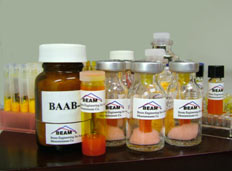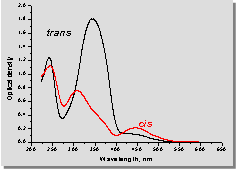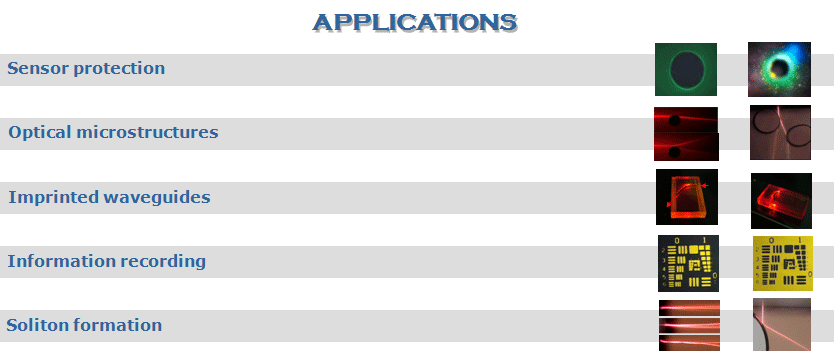
| LC |
T[oC] |
n2 [cm2/W] (a) |
Einc [J/cm2] (b) |
Eiso [J/cm2] (c) |
Dn (d) |
D [cm2/s] (e) |
e⊥ |
e|| |
UFr [V] |
| 1005 |
12.5 N 48.5 I |
2.0×10-1 |
0.073 |
0.39 |
0.18 |
5.3×10-6 |
3.0 |
3.4 |
8.2 |
| 1006 |
15 N 53 I |
2.1×10-1 |
0.074 |
0.39 |
0.18 |
5.2×10-6 |
3.2 |
3.6 |
9.7 |
| 1007 |
17 N 52 I |
2.4×10-1 |
0.077 |
0.51 |
0.18 |
5×10-6 |
3.2 |
3.7 |
9.9 |
| 1205 |
8 N 59 I |
2.1×10-1 |
0.13 |
0.73 |
0.21 |
6.3×10-6 |
3.2 |
4.0 |
9.5 |
| 1207 |
16.5 N 63.5 I |
1.9×10-1 |
0.14 |
0.82 |
0.20 |
6.2×10-6 |
3.2 |
3.9 |
9.8 |
| 5721 |
8 N 70 I |
1.2×10-1 |
0.19 |
1.35 |
0.23 |
3.6×10-6 |
2.6 |
3.3 |
15 |
| 8621 |
SmA 22 N 72 I |
1.1×10-1 |
0.16 |
1.64 |
0.20 |
6.1×10-6 |
3.0 |
3.3 |
19.6 |
| 8721 |
SmA 28 N 72I |
1.1×10-1 |
0.16 |
1.68 |
0.21 |
8.7×10-6 |
3.1 |
3.2 |
22.8 |
| 4911 |
2 N 56 I |
1.9×10-1 |
0.075 |
0.52 |
0.18 |
4.7×10-6 |
3.3 |
3.9 |
20.5 |
| 4915 |
-7 N 57 I |
2.1×10-1 |
0.067 |
0.47 |
0.18 |
4.1×10-6 |
3.1 |
3.7 |
17 |
| 4955 |
4 N 63 I |
2.1×10-1 |
0.13 |
0.93 |
0.20 |
4.4×10-6 |
3.0 |
3.7 |
19.8 |
| 4913 |
3 N 52 I |
2.0×10-1 |
0.076 |
0.60 |
0.20 |
4.2×10-6 |
3.0 |
3.6 |
18 |
| 4953 |
4 N 57 I |
2.0×10-1 |
0.10 |
0.79 |
0.21 |
4×10-6 |
3.0 |
3.5 |
16.3 |
| 3178 |
18 N 41.5 I |
1.8×10-1 |
0.058 |
0.28 |
0.14 |
5.5×10-6 |
2.4 |
3.2 |
8.5 |
| 3155 |
3 N 48 I |
2.2×10-1 |
0.11 |
0.43 |
0.20 |
5.1×10-6 |
2.6 |
3.3 |
7.5 |
| D307 |
3 N 34 I |
3.2 ×10-1 |
0.016 |
0.1 |
0.20 |
|
|
|
|
(a) l = 532 nm, I = 4.4×10-7 W/cm2, E||n (E: light polarization; n: LC orientation), L = 10 mm; (b) l = 409 nm, I = 6.2×10-3 W/cm2, L = 10 mm, E||n (L is the thickness of LC layer); (c) l = 409 nm, I = 6.2×10-3 W/cm2, L = 10 mm, E||n; (d) l = 633 nm, T = 23oC; (e) l = 633 nm, T = 23oC
Constant of nonlinear refraction n2: determines the change in the refractive index n – n0 of the material under the influence of a light beam of power density I according to the formula n – n0 = n2I.
Incubation energy Einc: determines the amount of light energy that the LC has to be exposed to in order to start photoinduced mesophase-isotropic phase transition.
Transition energy Eiso: determines the amount of light energy that LC has to be exposed to in order for the material to be transformed into isotropic phase.
Optical anisotropy Dn: is defined as the difference between the principal values of the refractive indices of LC.
Constant of "orientation diffusion" D: allows to evaluate the free relaxation time t of LC director reorientation in cells of thickness L with hard anchoring boundary conditions with the aid of the formula t = L2/D. The constant of “orientation diffusion” D is related with the orientational viscosity g and the elastic constant K1 of the liquid crystal by the expression D = p2K1/g.
Constants of dielectric susceptibility: e⊥ and e|| are the principal values of the dielectric susceptibility of NLC at 1 kHz.
Freedericks transition threshold UF: the minimum voltage necessary to apply to the NLC cell in order to induce NLC reorientation.





